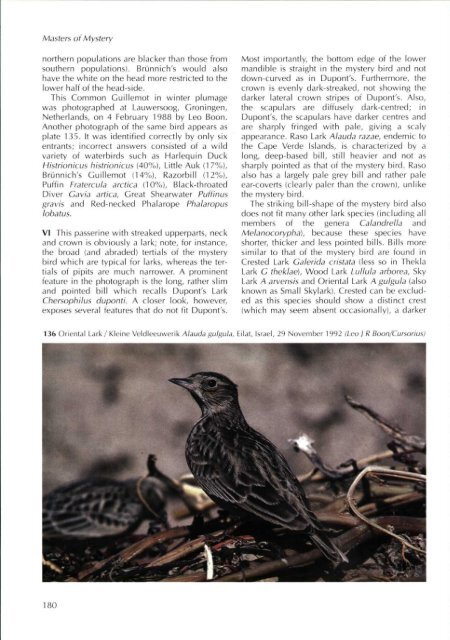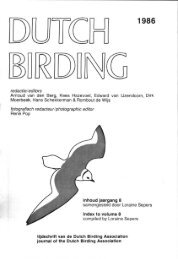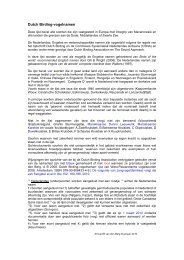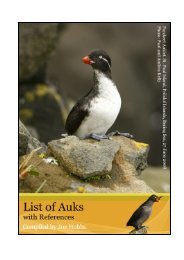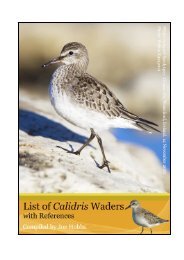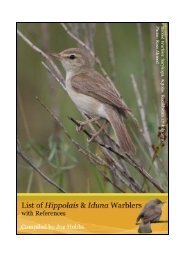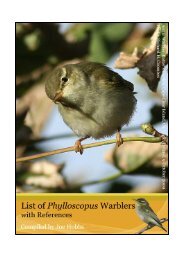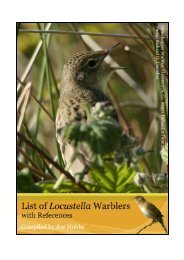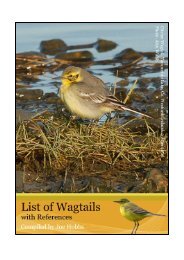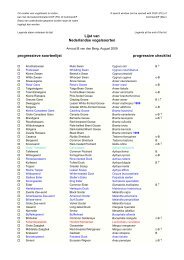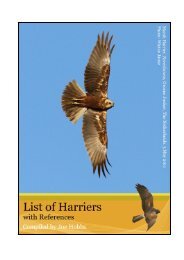1998-4 - Dutch Birding
1998-4 - Dutch Birding
1998-4 - Dutch Birding
You also want an ePaper? Increase the reach of your titles
YUMPU automatically turns print PDFs into web optimized ePapers that Google loves.
Masiers oÍ Myster y<br />
northern populations are blacker than those from<br />
southern populations). Brunnich's would also<br />
have the white on the head more restricted to the<br />
lower half of the head-side .<br />
This Common Guillernot in winter plumage<br />
was photographed at Lauwersoog• Groningen,<br />
Net herlands, on 4 February 1988 by Leo Boon .<br />
Another photograph of the same hird appears as<br />
plate 135 . It was identified correctly h•v only six<br />
entra nts; incorrect answers consisted of a wild<br />
variety oi waterbirds such as Harlequin Duck<br />
Histrionicus histrionicus I 40% ,j, Little Auk (17°l. ),<br />
Br (innich's Guillemot ~14 1%l, Razorbill (12')1„),<br />
Puffin Fratercuha irctica (10'4~}, Black-thro~ted<br />
Diver Gavia artica, Great Shearwater Putfinus<br />
hravis and Red-necked Phalarope Phalaropus<br />
loha tu .c .<br />
V! This passerine with streaked upperparts, neck<br />
and crown is ohviously a lark ; note, for instance,<br />
the hroad (and abraded) tertials of the mystery<br />
hird which are typical for larks, whereas the tertials<br />
of pipits are much narrower. A prominent<br />
feature in rhe photot;raph is the long, rather slim<br />
and pointed bill which recalls Dupont's Lark<br />
Chersophilus dt iponti. A closer look, however,<br />
exposes several teatures that do not fit Dupont's .<br />
Most importantly, the bottom edge ot the lower<br />
mandible is straight in the mvstery bird and not<br />
down-curved as in Dupont's . Furthermore, the<br />
crown is evenly dlrk-streaked, not showing the<br />
darker lateral crown stripes or Dupont's . Also,<br />
the scapulars are diftusel•v dark-centred ; in<br />
Dupont's, the scapulars have darker centres and<br />
are sharply fringed with pale• giving a scaly<br />
appearance . Raso Lark Alauda razae, endemic to<br />
the Cape VErde Islands, is characterized by a<br />
long, deep-hased bill, still heavier and not as<br />
sharply pointed as that ot the mystery bird . Raso<br />
also has a large.l•v pale grey bill and rather pale<br />
ear-coverts {clearlv paler than the crownl, unlike<br />
the mystery bird .<br />
The striking bill-shape of the mystery bird also<br />
does not fit many other lark species (including all<br />
membe(s of the genera Calanclrelfa and<br />
h9elanucorypha), because these species have<br />
shorter, thicker and less pointed bills . Bills more<br />
similar to that of the mystery bird are iound in<br />
Crested Lark Galerida cristata (less so in Thekla<br />
Lark G theklae ), Wood Lark Lul1ula arborea, Sky<br />
Lark A arvensis and Oriental Lark A,s;ulgula ( also<br />
known as Small Skylark) . Crested can be excludcd<br />
as this species should show a clistinct crest<br />
(which may seem absent occasionally), a darke r<br />
13 6 ()rienral Lark 1 Kteine Veldieeuwerik Alaud.a gulgula, Eflat, Israel, 29 November 1 I iv 2 rLco 1 R 8oun/Cursori u<br />
91,,, •~<br />
4h..._~ .<br />
18 0


